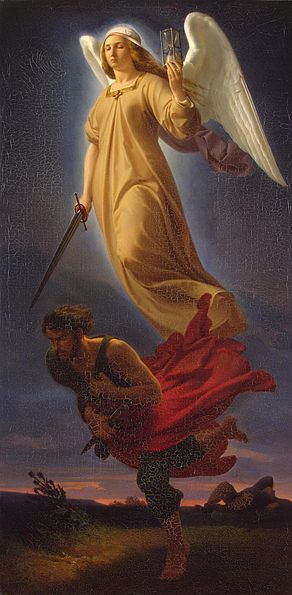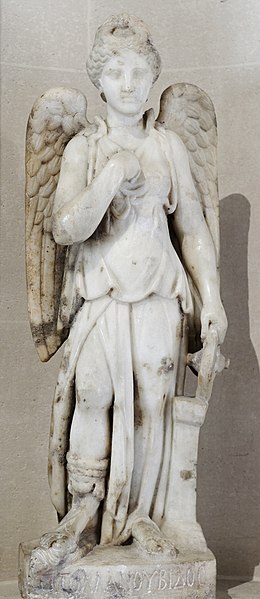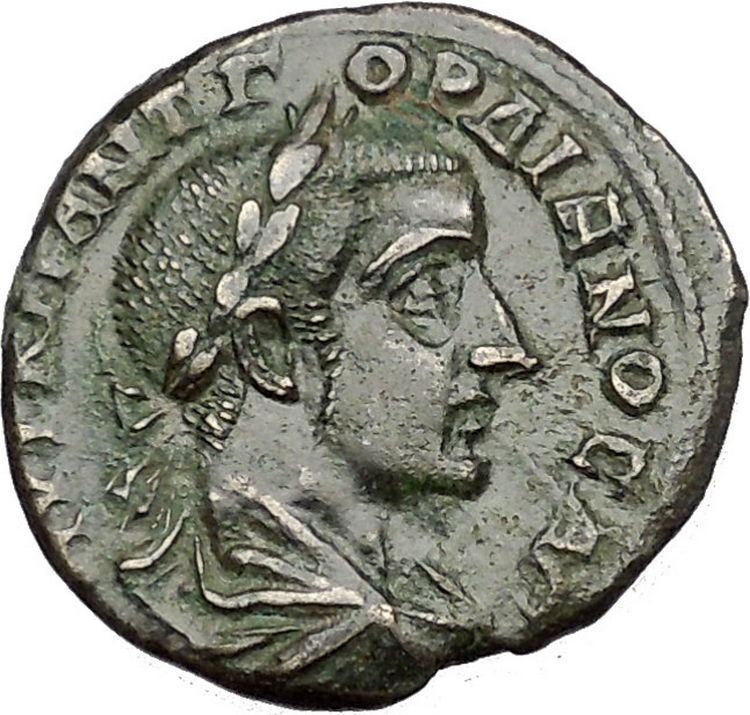|
Severus Alexander
–
Roman Emperor
: 222-235 A.D.
Severus Alexander
as Caesar
Bronze 25mm (7.05 grams) of Roman provincial mint
Marcianopolis in Moesia Inferior
Laureate, draped and cuirassed bust right.
V Π TIB IOVΛ ФHCTOV MAPKIANOΠOΛITΩN, [ under Legate Tiberius Julius Festus ] –
Nemesis
standing left holding scales and
scepter, wheel at feet.
You are bidding on the exact item pictured,
provided with a Certificate of Authenticity and Lifetime Guarantee of
Authenticity.
In
Greek mythology
, Nemesis (Greek,
Νέμεσις),
also called Rhamnousia/Rhamnusia (“the
goddess
of
Rhamnous
“) at her sanctuary at
Rhamnous
, north of
Marathon
, was the spirit of divine
retribution
against those who succumb to
hubris
(arrogance before the gods). Another
name was Adrasteia, meaning “the inescapable.” The Greeks personified
vengeful fate
as a remorseless goddess: the goddess of
revenge. The name Nemesis is related to the
Greek
word νέμειν [némein], meaning “to give
what is due”.
Background
Divine retribution is a major theme in the Hellenic world view, providing the
unifying theme of the
tragedies
of
Sophocles
and many other literary works.
Hesiod
states: “Also deadly
Nyx
bore Nemesis an affliction to mortals
subject to death.” (Theogony,
223, though perhaps an interpolated line). Nemesis appears in a still more
concrete form in a fragment of the epic
Cypria
.
She is implacable justice: that of
Zeus in the
Olympian
scheme of things, although it is clear
she existed prior to him, as her images look similar to several other goddesses,
such as Cybele
,
Rhea
,
Demeter
and
Artemis
.
As the “Goddess of Rhamnous”, Nemesis was honored and placated in an archaic
sanctuary in the isolated district of Rhamnous, in northeastern
Attica
. There she was a daughter of
Oceanus
, the primeval river-ocean that
encircles the world.
Pausanias
noted her iconic statue there. It
included a crown of stags and little
Nikes
and was made by
Pheidias
after the
Battle of Marathon
(490 BC), crafted from a
block of Parian
marble
brought by the overconfident Persians,
who had intended to make a memorial
stele
after their expected victory.
Origins
Nemesis has been described as the daughter of
Oceanus
or
Zeus, but according to
Hesiod
she was a child of
Erebus
and
Nyx.
She has also been described as the daughter of Nyx alone. Her cult may have
originated at Smyrna
.
In some metaphysical mythology, Nemesis produced the egg from which hatched
two sets of twins:
Helen of Troy
and
Clytemnestra
, and the
Dioscuri
,
Castor and Pollux
. While many myths indicate
Zeus and
Leda
to be the parents of
Helen of Troy
, the author of the compilation of
myth called
Bibliotheke
notes the possibility of
Nemesis being the mother of Helen; Nemesis, to avoid Zeus, turns into a goose,
but he turns into a swan and mates with her. Nemesis in her bird form lays an
egg that is discovered in the marshes by a shepherd, who passes the egg to
Leda
. It is in this way that
Leda
comes to be the mother of
Helen of Troy
, as she kept the egg in a chest
until it hatched.
Ac ts ts
and Deeds
Although a respected goddess, Nemesis had brought much sorrow to mortals like
Echo
and
Narcissus
. Narcissus was a very beautiful and
arrogant hunter from the territory of
Thespiae
and
Boeotia
who disdained the ones who loved him.
Nemesis lured him to a pool where he saw his own reflection in the water and
fell in love with it, not realizing it was only an image. He was unable to leave
the beauty of his reflection and he eventually died. Nemesis believed that no
one should ever have too much good, and she had always cursed those who were
blessed with countless gifts.
Fortune and
retribution
The word Nemesis originally meant the distributor of fortune, neither
good nor bad, simply in due proportion to each according to what was deserved;
then, nemesis came to suggest the resentment caused by any disturbance of
this right proportion, the sense of justice which could not allow it to pass
unpunished.
O. Gruppe
(1906) and others connect the name
with “to feel just resentment”. From the 4th century onwards, Nemesis, as the
just balancer of
Fortune
‘s chance, could be associated with
Tyche
.
In the
Greek tragedies
Nemesis appears chiefly as the
avenger of crime and the punisher of
hubris
, and as such is akin to
Atë
and the Erinyes
. She was sometimes called “Adrasteia“,
probably meaning “one from whom there is no escape”; her epithet Erinys
(“implacable”) is specially applied to Demeter and the
Phrygian
mother goddess,
Cybele
.
Local cult
A festival called Nemeseia (by some identified with the Genesia)
was held at Athens
. Its object was to avert the nemesis of
the dead, who were supposed to have the power of punishing the living, if their
cult had been in any way neglected (Sophocles,
Electra
, 792;
E. Rohde
, Psyche, 1907, i. 236, note I).
At Smyrna
there were two manifestations of
Nemesis, more akin to
Aphrodite
than to Artemis. The reason for this
duality is hard to explain; it is suggested that they represent two aspects of
the goddess, the kindly and the implacable, or the goddesses of the old city and
the new city refounded by Alexander. The martyrology Acts of
Pionius
, set in the “Decian
persecution” of AD 250–51, mentions a lapsed Smyrnan Christian who
was attending to the sacrifices at the altar of the temple of these Nemeses.
Rome
Pax-Nemesis was worshipped on occasion at
Rome by victorious generals, and in imperial times was the patroness
of gladiators
and of the venatores, who
fought in the arena with wild beasts, and was one of the
tutelary deities
of the drilling-ground (Nemesis
campestris). Sometimes, but rarely, seen on imperial coinage, mainly under
Claudius
and
Hadrian
. In the 3rd century AD there is
evidence of the belief in an all-powerful Nemesis-Fortuna. She was
worshipped by a society called Hadrian’s freedmen. The poet
Mesomedes
wrote a hymn to Nemesis in the early
2nd century CE, where he addressed her
- Nemesis, winged balancer of life,
- dark-faced goddess, daughter of Justice,

and mentioned her “adamantine bridles” that restrain “the frivolous
insolences of mortals.”
In early times the representations of Nemesis resembled Aphrodite, who
herself sometimes bears the epithet Nemesis. Later, as the maiden goddess of
proportion and the
avenger of crime
, she has as attributes a
measuring rod
(tally
stick), a
bridle
,
scales
, a
sword
and a
scourge
, and rides in a
chariot
drawn by
griffins
.
Nemesis is also known to have been called “Adrastia“.
Ammianus Marcellinus includes her in a digression on Justice following his
description of the death of Gallus Caesar.
In modern literature
Percy Jackson & the Olympians
– Nemesis
is mentioned as the goddess of revenge, and the mother of a minor
antagonist, Ethan Nakamura, who claims Nemesis traded his eye for power.
The Heroes of Olympus
– Nemesis appears
in
The Mark of Athena
, and gives
Leo Valdez
a
fortune cookie
that can solve a problem he
cannot solve on his own, for a price. She is mentioned to have a motorcycle
with
Pac-Man
-like wheels.- Project: Nemesis is about a
kaiju
who was the basis for the myth of
Nemesis. In the novel the monster is resurrected using the DNA of a murdered
girl and cuts a path of destruction to Boston so it can exact revenge on the
murderer.
- Nemesis by Agatha Christie. The main protagonist, Miss Jane Marple,
an elderly woman who often finds herself solving murders, describes herself
as ‘Nemesis’.
Marcianopolis, or Marcianople was an ancient Roman city in
Thracia
. It was located at the site of modern
day Devnya
,
Bulgaria
.
The city was so renamed by Emperor
Trajan
after his sister
Ulpia Marciana
, and was previously known as
Parthenopolis. Romans repulsed a
Gothic
attack to this town in
267
(or 268
), during the reign of
Gallienus
.
Diocletian
made it the capital of the
Moesia Secunda
province.
Valens
made it his winter quarters in 368 and
succeeding years, Emperor
Justinian I
restored and fortified it. In 587,
it was sacked by the king of the
Avars
but at once retaken by the Romans. The
Roman army quartered there in 596 before crossing the Danube to assault the
Avars.
Between 893 and 972 it was one of the most important medieval cities in
south-eastern Europe.
SEVERUS ALEXANDER
 Augustus: Augustus:
A.D. 222-235
Caesar: A.D. 221-222 under Elagabalus
Son of Julia Mamaea
Husband of Orbiana
Grandson of Julia Maesa
Nephew of Julia Soaemias
Cousin of Elagabalus
Second-cousin of Caracalla and Geta
Great-newphew of Septimius Severus and Julia Domna
Marcus
Aurelius Severus Alexander (October 1, 208–March 18, 235 AD), commonly
called Alexander Severus, was the last
Roman emperor
(11 March 222–235) of the
Severan dynasty
. Alexander Severus succeeded his cousin,
Elagabalus
upon the latter’s assassination in 222 AD, and was ultimately assassinated
himself, marking the
epoch event
for the
Crisis of the Third Century
—nearly fifty years of disorder, Roman civil
wars, economic chaos, regional rebellions, and external threats that brought the
Empire to near-collapse.
Alexander Severus was the
heir
apparent
to his cousin, the eighteen-year-old Emperor who had been murdered
along with his mother by his own guards—and as a mark of contempt, had their
remains cast into the
Tiber river
. He and his cousin were both grandsons of the influential and
powerful Julia Maesa
, who had arranged for Elagabalus’ acclamation as Emperor by the
famed
Third Gallic Legion
.
A rumor of Alexander’s death circulated, triggering the assassination of
Elagabalus.
Alexander’s reign was marked by troubles. In military conflict against the
rising
Sassanid Empire
, there are mixed accounts, though the Sassanid threat was
checked. However, when campaigning against
Germanic tribes
of
Germania
,
Alexander Severus apparently alienated his legions by trying diplomacy and
bribery, and they assassinated him.
Life
Alexander was born with the name Marcus Julius Gessius Bassianus Alexianus.
Alexander’s father,
Marcus Julius Gessius Marcianus
was a Syrian
Promagistrate
. His mother
Julia Avita Mamaea
was the second daughter of
Julia
Maesa
and Syrian noble
Julius Avitus
and maternal aunt of Emperor
Elagabalus
.
He had an elder sister called Theoclia and little is known about her.
Alexander’s maternal great-aunt was empress
Julia
Domna
(also Maesa’s younger sister) and his great-uncle in marriage was
emperor Lucius
Septimius Severus
. Emperors
Caracalla
and
Publius Septimius Geta
, were his mother’s maternal cousins. In 221,
Alexander’s grandmother, Maesa, persuaded the emperor to adopt his cousin as
successor and make him
Caesar
and Bassianus changed his name to Alexander. In the following
year, on March 11, Elagabalus was murdered, and Alexander was proclaimed emperor
by the
Praetorians
and accepted by the Senate.
When Alexander became emperor, he was young, amiable, well-meaning, and
entirely under the dominion of his mother. Julia Mamaea was a woman of many
virtues, and she surrounded the young emperor with wise counsellors. She watched
over the development of her son’s character and improved the tone of the
administration. On the other hand, she was inordinately jealous. She also
alienated the army by extreme parsimony, and neither she nor her son were strong
enough to impose military discipline. Mutinies became frequent in all parts of
the empire; to one of them the life of the jurist and praetorian praefect
Ulpian
was
sacrificed; another compelled the retirement of
Cassius
Dio
from his command.
On the whole, however, the reign of Alexander was prosperous until the rise,
in the east, of the
Sassanids
. Of the war that followed there are various accounts. (Mommsen
leans to that which is least favourable to the Romans). According to Alexander’s
own dispatch to the senate, he gained great victories. At all events, though the
Sassanids were checked for the time, the conduct of the Roman army showed an
extraordinary lack of discipline. The emperor returned to
Rome and celebrated
a triumph in 233.
The following year he was called to face German invaders in
Gaul, who had
breached the Rhine frontier in several places, destroying forts and over-running
the countryside. Alexander mustered his forces, bringing legions from the
eastern provinces, and crossed the Rhine into Germany on a pontoon bridge.
Initially he attempted to buy the German tribes off, so as to gain time. Whether
this was a wise policy or not, it caused the Roman legionaries to look down on
their emperor as one who was prepared to commit unsoldierly conduct.
Herodian
says “in their opinion Alexander showed no honourable intention to pursue the
war and preferred a life of ease, when he should have marched out to punish the
Germans for their previous insolence”. These circumstances drove the army to
look for a new leader. They chose
Gaius Iulius Verus Maximinus
, a Thracian soldier who had worked his way up
through the ranks.
Following the nomination of Maximinus as emperor, Alexander was slain (on
either March 18 or March 19, 235), together with his mother, in a mutiny of the
Primigenia Legio XXII
. These assassinations secured the throne for
Maximinus.
The death of Alexander is considered as the end of the Principate
system established by
Augustus
.
Although the Principate continued in theory until the reign of
Diocletian
,
Alexander Severus’ death signalled the beginning of the chaotic period known as
the
Crisis of the Third Century
which weakened the empire considerably.
Legacy
Alexander was the last of the Syrian emperors. Under the influence of his
mother, he did much to improve the morals and condition of the people. His
advisers were men like the famous jurist Ulpian, the historian Cassius Dio and a
select board of sixteen senators; a municipal council of fourteen assisted the
urban praefect in administering the affairs of the fourteen districts of Rome.
The luxury and extravagance that had formerly been so prevalent at the court
were put down; the standard of the coinage was raised; taxes were lightened;
literature, art and science were encouraged; the lot of the soldiers was
improved; and, for the convenience of the people, loan offices were instituted
for lending money at a moderate rate of interest.
In religious matters Alexander preserved an open mind. It is said that he was
desirous of erecting a temple to the
founder of
Christianity
, but was dissuaded by the pagan priests.
Marriage
Alexander was married three times. His most famous wife was
Sallustia Orbiana
,
Augusta
, whom he married in 225. He divorced and exiled her in 227,
after her father,
Seius Sallustius
, was executed for attempting to assassinate the emperor.
Another wife was Sulpicia Memmia. Her father was a man of consular rank; her
grandfather’s name was Catulus.
|







 Augustus:
Augustus:


